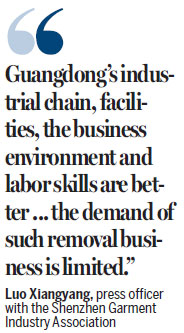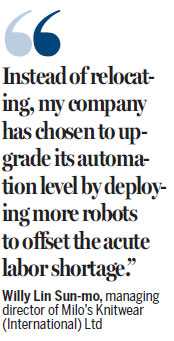Factory exodus fuels logistics boom
As operators of labor-intensive factories scramble to move out of the Pearl River Delta (PRD) region and relocate to Southeast Asia, taking advantage of the lower operational and labor costs there, logistics companies are riding high on the exodus despite the challenges confronting them.
But, industry experts point out that factory relocation is a much more complicated process than homes removal, as it involves equipment from an entire assembly line and it's extremely difficult to transport them.
According to Guan Tianwen, a manager at Guangzhou Mingtong Heavy Logistics Co Ltd, the process is compounded by the problem of safety, and professionals have to be brought in.
"Assembly line workers would not know how to dismantle, hoist or load these devices, so they need professionals to do the job to guarantee their safety," he told China Daily.
 |
|
Workers assemble monitors at a TCL Corp factory in Huizhou, Guangdong province. Rising labor costs and stiff competition have driven some factories out of the Pearl River Delta region, which used to host vast clusters of manufacturers. Relocating the factories to markets with lower operational costs, such as Southeast Asia, however, is a different story. Shen Qilai / Bloomberg |
It's also costly for factory operators to install new machines abroad and, most importantly, some of the equipment are tailor-made and could not be purchased in Southeast Asian countries. So, they're forced to reuse them, he said.
Guan said time is another crucial factor in moving factories to other countries as the process would take much longer, coupled with the intense preparations needed to set up the new plant and hire local staff.
Companies like Mingtong are involved in uploading and transporting the equipment domestically, while the overseas role has to be taken up by professional clearance companies.

Dongguan Pantom International Freight Forwarders Co Ltd, which used to "import" new and second-hand electro-mechanical equipment since its establishment in 2008, has now started "exporting" them.
Martin Cheung, a manager with the company, said many factories in the PRD have moved out, or are planning to relocate to Southeast Asia, lured by the cheap labor costs there, so "importing" machinery is on the decline.
He said some of their clients need help to move their factory facilities abroad, so his company is now offering related services.
But, he said, the most difficult and costly part of the operation concerns customs clearance as some of the factory equipment have special functions, and it's hard to identify their customs code.
"Thus, the relationships we've set up, as well as the experience gained from our previous import business, come in handily," he said.
According to Cheung, the traditional method to move such equipment to Southeast Asia is by sea although many companies now reckon that land transportation is more efficient.
A businessman, who runs a logistics enterprise in the PRD, said transporting machinery by land to Myanmar, for instance, would take just 15 days - twice as fast as by sea - according to a Hong Kong media report.
He would choose heavy freight trunk routes from Yunnan province to enter Myanmar, and most of his clients are in the clothing, bags and shoe manufacturing business, about 40 percent of which involves Hong Kong investment.
He admitted being able to reap a net profit of at least 10,000 yuan ($1,450) for each operation, removing sewing machines, electric generators and clothing material for some 25 factories located in Shenzhen, Dongguan, Zhuhai and other cities in Guangdong province in the first 10 months of this year.
His company also provides furnishing and decoration services for these new factories. There are also other companies offering packaged services, including company registration, renting of land and factory construction at their new locations.
Industry insiders, however, warned that these companies are also in the labor-intensive business, and face similar problems like high labor costs and stiff competition.
Luo Xiangyang, a press officer with the Shenzhen Garment Industry Association, said most of the factories relocating to Myanmar are OEMs (original equipment manufacturers) and their number is not very high.

"Guangdong's industrial chain, facilities, the business environment and labor skills are better," he said, so he believes that the demand of such removal business is limited.
"In Shenzhen, in particular, the clothing companies are mostly focused on establishing their own brands and developing the domestic market, so they would not move out."
Chen Linyan, general manager of the Shenzhen Logistics Industry Association, told China Daily she has yet to see a distinct surge in the number of logistic operators among its members that are involved in the business of helping factories moving abroad.
There are no specific charging standards in this field, she noted, and that could be a barrier for the business to grow.
Although the cost of moving one container equipment is about 10,000 yuan on average, the logistics fee usually varies, depending on the type of machine to be delivered, Cheung said.
For small and medium-sized manufacturers, the removal cost presents a sort of challenge, considering they also need to spend millions of dollars on the acquisition of land, buildings and talents, said Willy Lin Sun-mo, managing director of Milo's Knitwear (International) Ltd.
Instead of relocating, Lin said his company has chosen to upgrade its automation level by deploying more robots to offset the acute labor shortage.
grace@chinadailyhk.com
(HK Edition 12/06/2016 page9)



 Print
Print Mail
Mail

